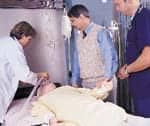The partners behind Valley CORF envision a “one-stop shop” for patients with COPD and other respiratory ailments.
When Valley CORF opened its doors in Tarzana, Calif, in October 2003, it gave individuals in the surrounding San Fernando Valley who suffer from respiratory problems a place to improve their health and their overall quality of life at the same time.

“A lot of hospitals in the area stopped offering outpatient pulmonary rehab,” CEO Ely Sorkin says. “We saw that there was a niche that needed to be filled.”
A CORF or Comprehensive Outpatient Rehabilitation Facility is a Medicare-certified facility that can provide various outpatient services. CORFs also take private insurance patients.
While Valley CORF provides all types of physical therapy, its main focus is pulmonary rehabilitation. Without a pulmonary rehab program, the only treatment that many respiratory patients receive is home oxygen, Sorkin says.
“Oxygen only sustains their quality of life, active rehabilitation increases their quality of life,” he says.
“With COPD patients, there is a big depression component,” Sorkin says, adding that limited mobility can lead to isolation, which only fuels the depression that often comes with the diagnosis of a disease. “It’s a continuous downward spiral.”
The active rehabilitation program Valley CORF provides focuses on increasing patients’ stamina, endurance, and overall quality of life.
The 3,600-square-foot facility includes two 300-square-foot gyms. The staff includes two full-time respiratory therapists, two physical therapists, and a social worker and dietician who come to Valley CORF when needed.
Valley CORF’s COO, Azmina Shamji-Kanji, says the facility’s intimate setting is part of what sets its care apart.
“Our care is tailor-made to patients’ needs, compared to the care of some of the larger facilities. There is a customization of each patient’s needs here,” she says.
Among Valley CORF’s pulmonary rehabilitation programs are those for patients with asthma, bronchitis, and COPD. While the center treats patients of all ages, the majority are seniors with COPD.
Patients are referred to the facility by their physician and receive an evaluation during their first visit. After a rehabilitation program is designed specifically for a patient’s needs, the patient spends 1 hour, three times a week, for 8 to 12 weeks in the facility’s gym, using various equipment, including treadmills, bicycles, an incentive spirometer, an arm ergometer, weight machines, and free weights. The staff also teaches patients about proper breathing techniques, and educates them about their disease.
“Without a program like this, lung volumes would continue to decrease and deteriorate unless the patients took some proactive measures on their own,” says Terry Dennis, RT, RCP.
At the end of the program, patients have the option of continuing to come to the gym on a maintenance program on their own for a fee.

At 101 years of age, Charles Jones is continuing his rehabilitation from chronic bronchitis on a maintenance program.
“It’s really nice to have this continuation of the program,” says his son, Robert Jones, who brings his father to the center. “Before he started, he’d walk about 10 feet and be totally out of breath. Now he goes two miles on a bike.”
The elder Jones often passes his time on the bicycle by singing songs.
“They did a terrific job,” he says of the staff. “It’s easier now to breathe.”
Sorkin calls Jones “remarkable.”
“He’s walking on his own and does exercises better than people who are 25 years younger,” Sorkin says.
Patients should come to Valley CORF prepared to work during their rehabilitation program and on maintenance.
“This is not just an 8- or 12-week vacation. This is something they have to continue to do to [maintain the condition of their lungs],” Dennis says. “We get them independent again.”
Sorkin says the staff knows how to “gently push” patients to help improve their performance. A note on a board in the gym confirms that, letting patients know “This is your time. Stay motivated.”
Although Josephine Merheg, 83, still suffers from shortness of breath after battling severe pneumonia before and after open heart surgery, she credits the Valley CORF staff with helping wean her oxygen dependence from all-day usage to nighttime only.
“It’s the best place I have ever been in, and I have been in a lot of places. They brought me here in a wheelchair, and now I’m walking like a horse,” Merheg says, laughing. “These people are unbelievable. If I could, I would come every day.”
For 65-year-old Roylan Harris, who is battling emphysema after years of smoking, progress is measured in steps.
“I know I’m not getting any worse, but maybe my hopes were too high,” he says. “I have good days and bad days. I don’t want to get any worse.”
Harris, who is on a maintenance program, hopes to one day build up his endurance and stamina enough to walk around his neighborhood again.
“It’s amazing when you see how far [patients] have come from the first time they came here,” says Lisa Gilbreath, RT, RCP.
In the near future, Sorkin and Kanji hope to create a COPD support group, set up a Web site with links to various lung and respiratory organizations, and offer speech and occupational therapies.
“Our goal is to become a one-stop shop for COPD patients to provide comprehensive care for them,” Sorkin says.
Danielle Cohen is a staff writer for RT.










